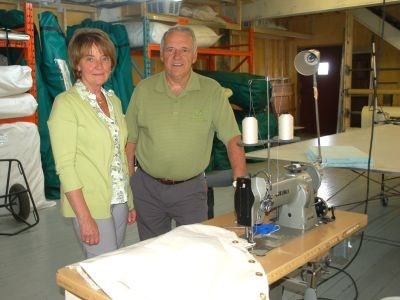Innovation and the ability to respond to customer needs have sustained Porcupine Canvas since it began 30 years ago.
Founded by Deni Poulin, he and his two employees began offering tent repairs and snowshoe restringing.
That, said manager and business partner Chris Pronovost, was the company's introduction to the exploration industry.
“That's what the prospectors at that time wanted,” Pronovost said. “They wanted their tents and snowshoes repaired. Then they said if we carried certain items like flagging tape, they would buy them.”
With the demise of the flow-through shares program in the 1980s, the Schumacher company began researching the mining industry and it progressed to making bags, covers and other products for the mines.
“We had to stop and refocus,” she said. “We had to keep our existing clientele but expand into other markets, so we concentrated our marketing and advertising to the mining industry and provided them with products and services that would ensure our longevity.”

This is one of a special series of articles that appeared in our July issue celebrating the 100th anniversary of the incorporation of the City of Timmins.
Its mainstay product has always been tents but those have also changed throughout the years. Porcupine Canvas now offers insulated tents after doing research and development into the new product.
“Most people buying our tents are using them all year' round,” Pronovost said. “And far up north, where -40 (C) is not the coldest temperature, it's important to offer this product.” Where heating is done by fuel oil and not wood, insulated tents become more of a priority.
“Our tents were never insulated before and it is a new market for us. We had to research how to make it as lightweight as possible and be a good product,” she said.
The triple-layered fabric is designed to retain heat and keep the elements and the cold out.
In summer, the tent's interior walls are kept cool. Glamping (glamorous camping) and eco-tourism are two areas the company is targetting.
“Glamping has become quite popular and that would still enhance our tent manufacturing end,” Pronovost said.
About eight years ago, the company started manufacturing tipis, which it now sells across the country. “We knew that was going to be an area that was good for us,” said Poulin. “We sell to mostly First Nations but also to some non- Aboriginal organizations.”
Sweat lodge covers are also manufactured but the canvas colour was changed from white to black. “One day we found out they were bringing other tarps to put on top of ours because they wanted it to be darker,” he said. “So we found a black canvas which cuts out most of the light.”
Along with tents, bags for the mining industry keep the company and its staff of eight to 10 employees busy.
“Bags can be anything from cases for eyeglasses or tools and can come in any shape or size,” Poulin said. “We have more than 300 products and certain ones we don't sell a lot of, but as a group, the bag line is quite successful. That's because we can customize for the customer and deliver in a timely fashion. We are known for our good turnaround. Our people are very skilled and quick.”
While the company uses three main materials – canvas, fire retardant canvas and vinyl – different fabrics are used for mine filtration since the process is precise.
“It is imperative to get the correct fabric, otherwise it would interfere with the processing,” Poulin said. A new material, which can be heated, is used for geofines bags which catch rock chips during the reverse drilling process.
The collected samples can be heated and dried in the bag up to a certain temperature. Both say mining processes, and even the supplies needed by the exploration industry, have changed over the years and so have their products.
“But that is OK,” Pronovost said. “We are doing more of other things and we do what we have to in order to stay ahead. That's why we are still here.”
www.porcupinecanvas.com 




